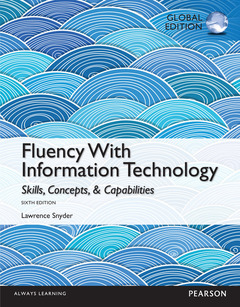Description
Fluency With Information Technology: Global Edition (6th Ed.)
Author: Snyder Lawrence
Language: English
784 p. · 21.6x27.6 cm · Paperback
Description
/li>Contents
/li>Comment
/li>
For the introduction to Computer Science course
Fluency with Information Technology: Skills, Concepts, and Capabilities equips readers who are already familiar with computers, the Internet, and the World Wide Web with a deeper understanding of the broad capabilities of technology. Through a project-oriented learning approach that uses examples and realistic problem-solving scenarios, Larry Snyder teaches readers to navigate information technology independently and become effective users of today?s resources, forming a foundation of skills they can adapt to their personal and career goals as future technologies emerge.
- PART 1 Becoming Skilled at Computing
- Chapter 1 Defining Information Technology
- Chapter 2 Exploring the Human-Computer Interface
- Chapter 3 The Basics of Networking
- Chapter 4 A Hypertext Markup Language Primer
- Chapter 5 Locating Information on the WWW
- Chapter 6 An Introduction to Debugging
- PART 2 Algorithms and Digitizing Information
- Chapter 7 Representing Information Digitally
- Chapter 8 Representing Multimedia Digitally
- Chapter 9 Principles of Computer Operations
- Chapter 10 Algorithmic Thinking
- PART 3 Data and Information
- Chapter 11 Social Implications of IT
- Chapter 12 Privacy and Digital Security
- Chapter 13 The Basics of Spreadsheets
- Chapter 14 Advanced Spreadsheets for Planning
- Chapter 15 Introduction to Database Concepts
- Chapter 16 A Case Study in Database Organization
- PART 4 Problem Solving
- Chapter 17 Fundamental Concepts Expressed in JavaScript
- Chapter 18 A JavaScript Program
- Chapter 19 Programming Functions
- Chapter 20 Iteration Principles
- Chapter 21 A Case Study in Algorithmic Problem Solving
- Chapter 22 Limits to Computation
- Chapter 23 A Fluency Summary
- Glossary
- Answers to Selected Questions
- Index
Skills, Concepts, and Capabilities Promote Lifelong Learning
Through three different types of content–skills, concepts, and capabilities–Fluency with Information Technologyprepares students to adapt to an ever-changing computing environment through lifelong learning:
- Skills consist of competence and proficiency with contemporary computer applications like email, word processing, and Web searching. Skills make the technology immediately useful to students and ground students’ learning of other content in practical experience.
- Concepts are the fundamental principles upon which information technology is based, such as how computers work, digital representation of information, and assessment of information authenticity. Concepts provide the principles on which students will build new understanding as IT evolves.
- Capabilities are the aptitude to apply higher-level thinking in complex situations, such as problem solving, reasoning, complexity management, and troubleshooting. Capabilities embody modes of thinking that are essential to exploiting IT, but they apply in many other situations as well.
Engaging Features Encourage Students to become Fluent with Information Technology (FIT)
In-chapter and end-of-chapter featuresinclude:
- fit TIP: Practical hints and suggestions for everyday computer use.
- fit BYTE: Interesting facts and statistics.
- fit CAUTION: Warnings and explanations of common mistakes.
- Try It: Short, in-chapter exercises with solutions provided.
- Checklists: A useful list of steps for completing a specific task.
- Great fit Moments: A historical look at some of the major milestones in computing.
- Gre




